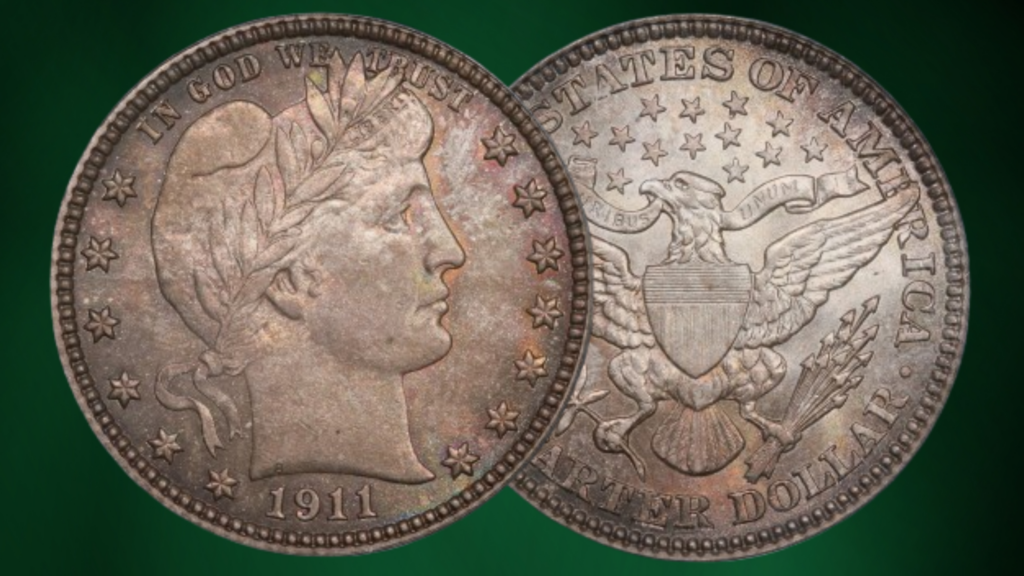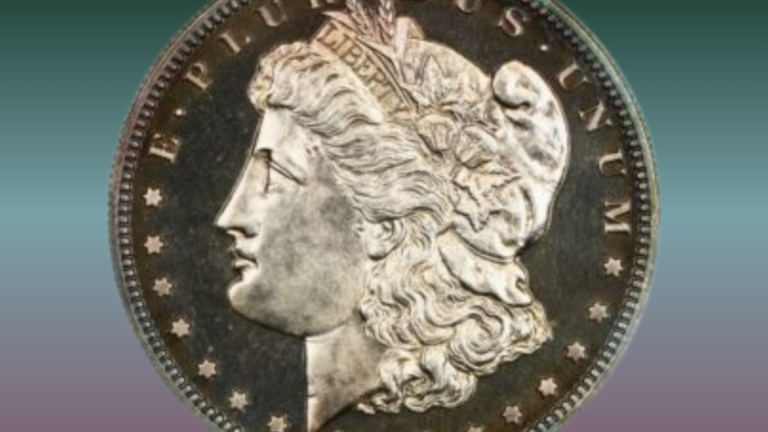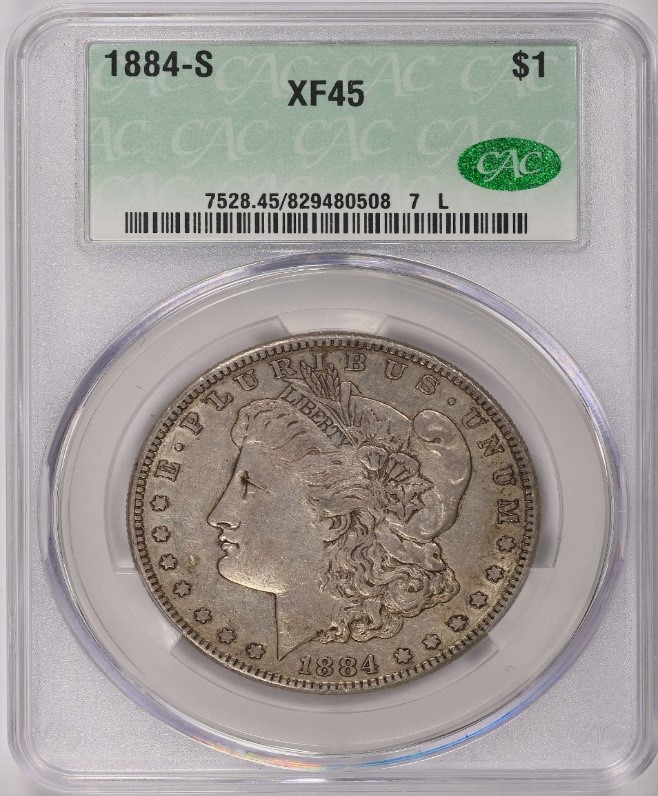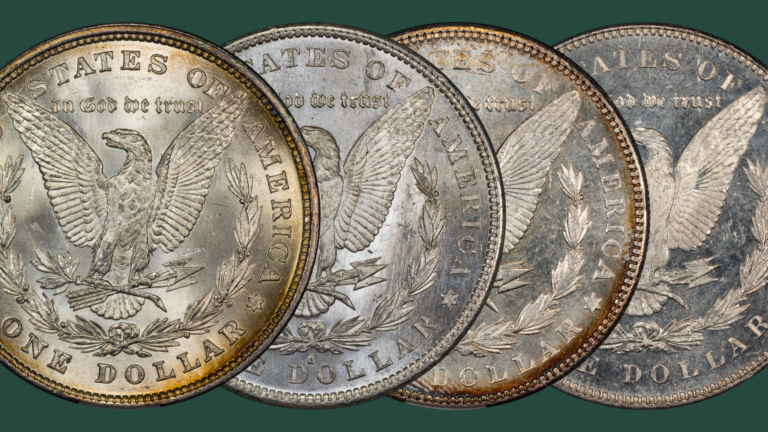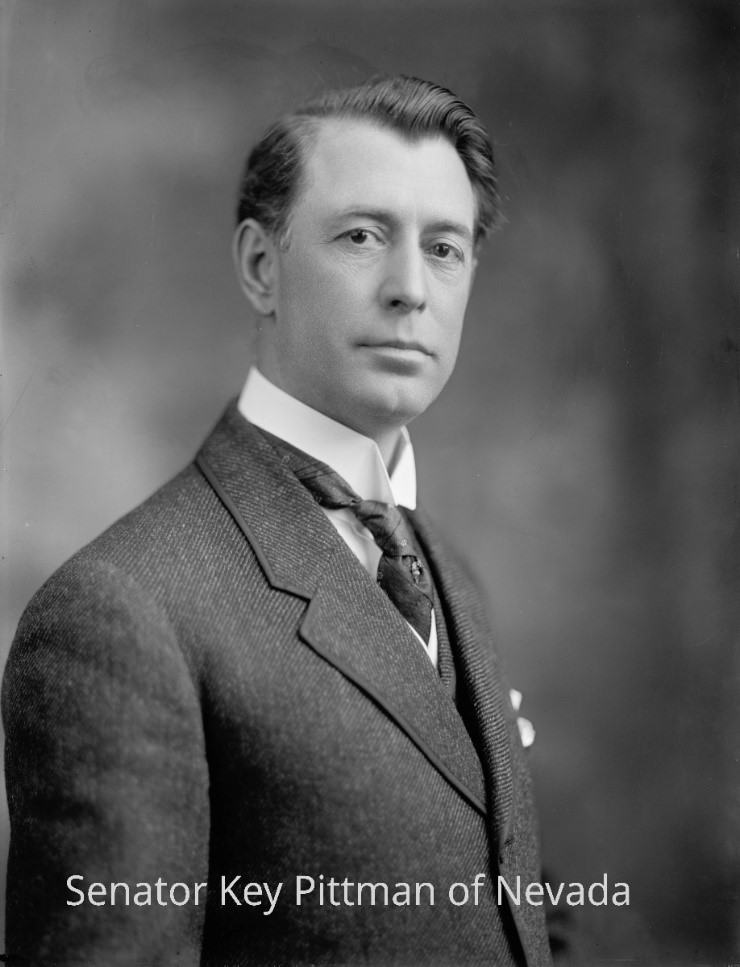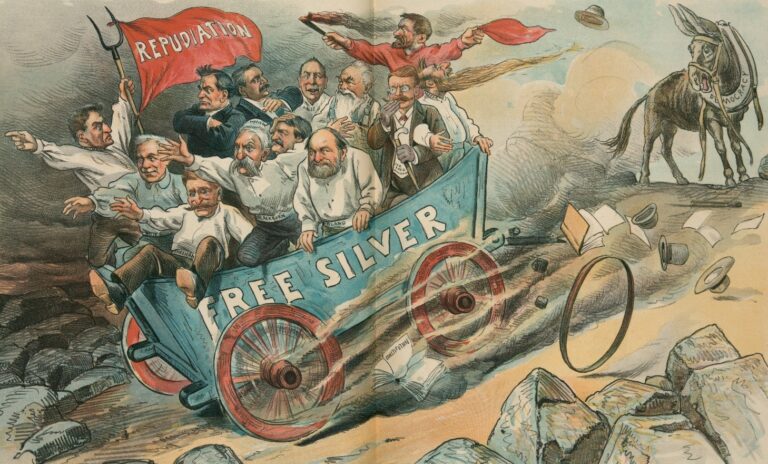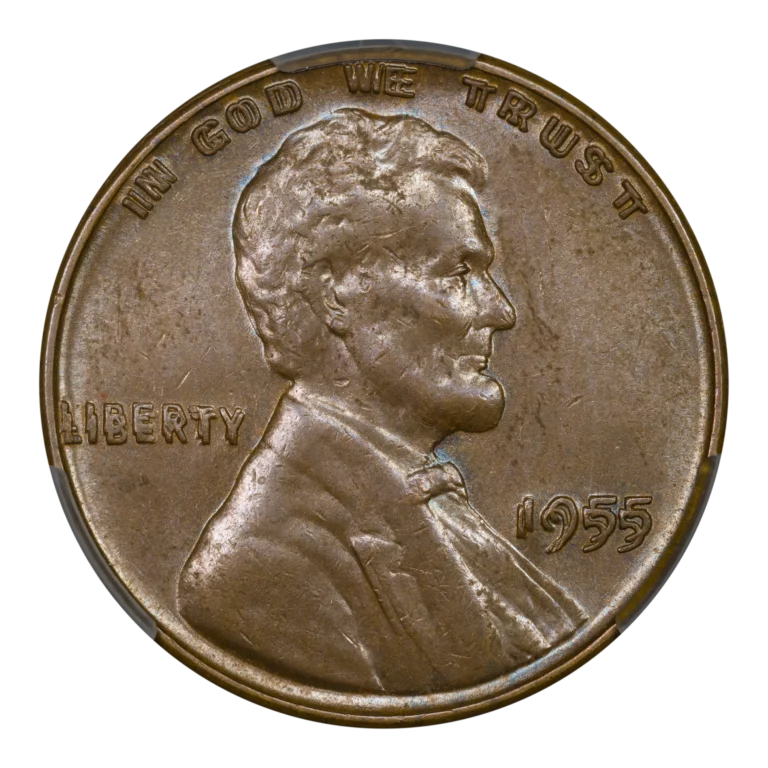by Greg Reynolds
For someone just getting started with Barber quarters, a set or run of twentieth century dates in circulated grades is a sensible option. Most of the dates included are not particularly expensive in the context of classic U.S. coins (1793 to the 1930s). Like Barber dimes, Barber quarters were minted from 1892 to 1916.
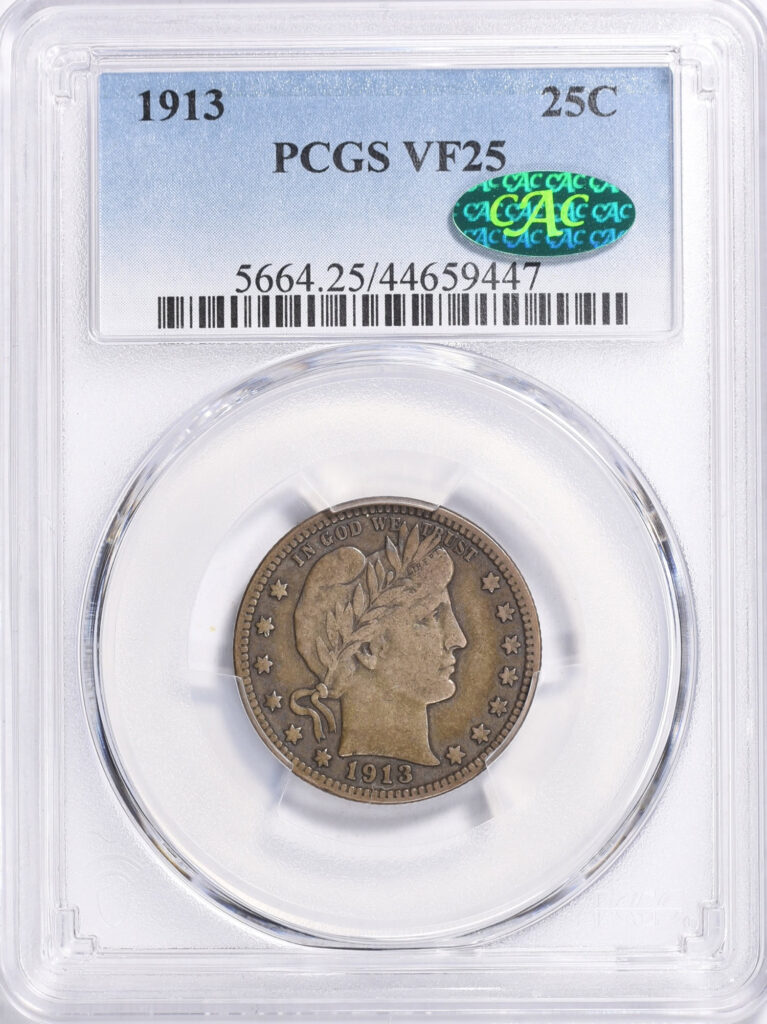
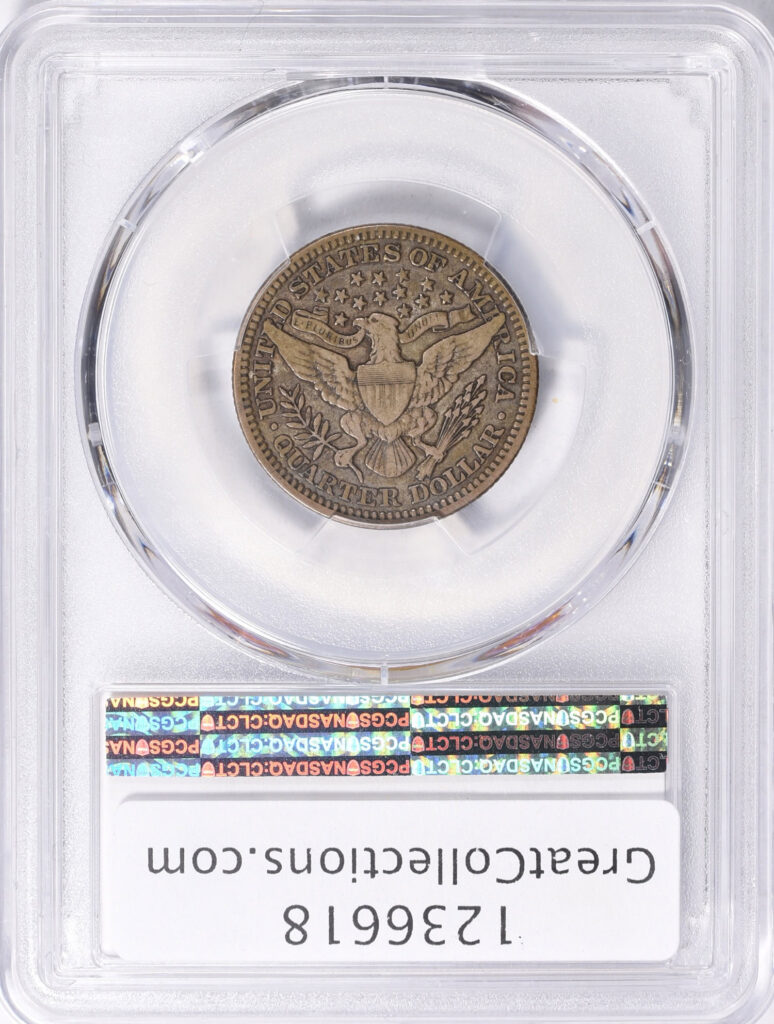
The three key dates are very expensive, the 1896-S, the 1901-S and the 1913-S. Circulated representatives of the keys and the semi-keys are covered in a separate discussion.
To collectors who do not have much experience with Barber coins, I suggest acquiring most of the rest of the dates before thinking about the keys to the series of Barber quarters. The process of searching for and acquiring numerous coins in a series usually leads to collectors learning about the series without consciously realizing that they are learning. Indeed, without thinking about learning, collectors often learn while having fun.
It is also true that collectors who do not wish to learn may enjoy completing sets without learning. Buying CAC stickered or CACG graded coins is relatively safe. Generally, I suggest that very casual collectors not spend ‘a lot of money’ on any one coin. By ‘a lot of money,’ I am referring to an amount that the respective collector regards as ‘a lot.’ An amount that one collector thinks of as very little may be a very large sum to another collector. It is important for collectors to think about their own budgets in the context of their own financial situations.
Grading fees and associated expenses, including shipping, have evolved such that it is usually not cost-effective for dealers to submit inexpensive circulated coins for grading. Collectors sometimes do so for fun. I suggest that collectors who have the time and some extra funds buy inexpensive Barber coins and submit them to CACG in Virginia. While this activity probably will not be profitable, it could be very educational.
There are many raw (not encapsulated) Barber quarters around, especially in grades below VF-30. There are also many PCGS or NGC graded coins that were never sent to CAC in New Jersey or to CACG in Virginia Beach, at least not yet. Therefore, while referencing the CAC population report, it is important to remember that there are many Barber quarters in existence that are not presently included in CAC data. For example, although the 1900 Philadelphia Mint issue is a slightly ‘better date,’ most surviving circulated 1900 quarters remain raw, not encapsulated by a grading service.
The Population of Barber Quarters
As of February 1, 2025, the total CAC population of 1900 quarters is only fifty-three. A ‘better date’ is scarcer than one of the least scarce dates, which are sometimes unfairly called “common dates.” A 1900 quarter will usually cost significantly more than an equivalent representative of one of the least scarce dates.
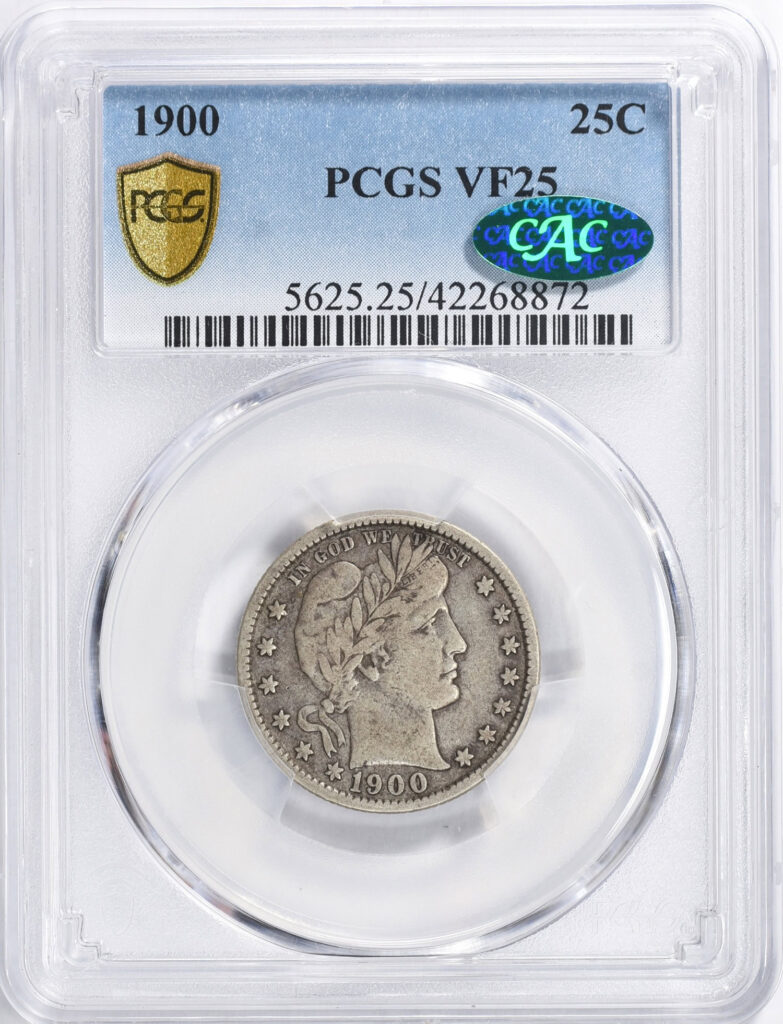
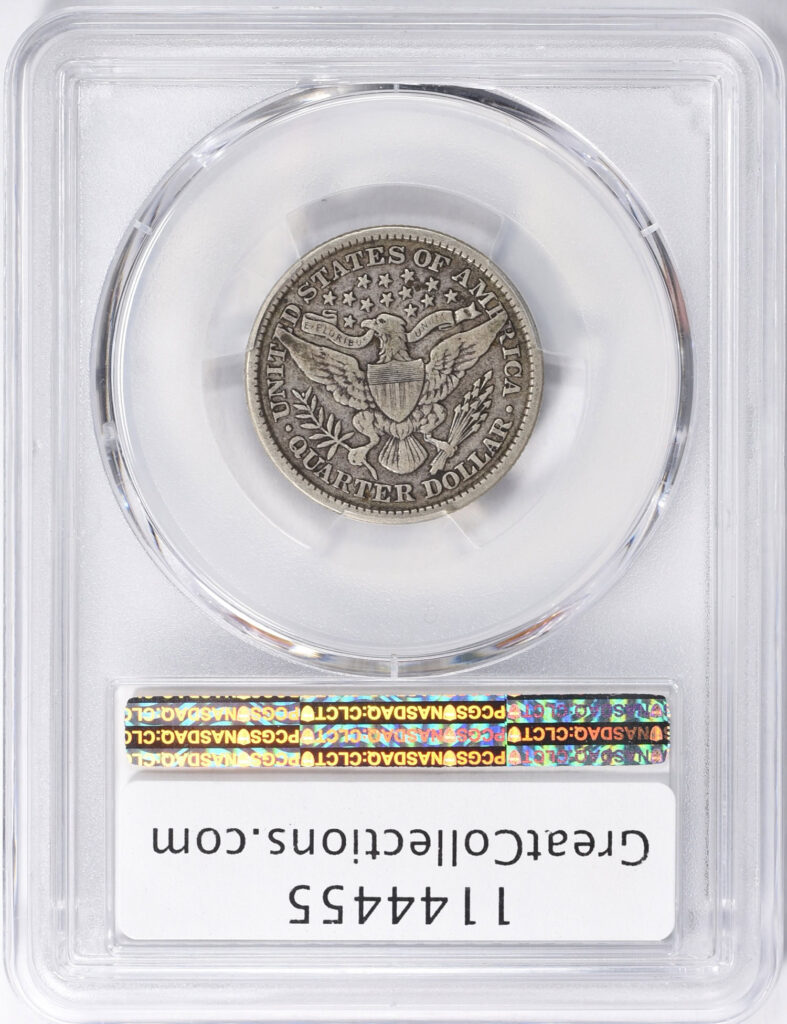
On April 17, 2022, GreatCollections sold a CAC approved VF-25 grade 1900 quarter for $102.30. Although the CPG-CAC retail estimate for an XF-40 grade 1900 is $105, this might be too low of an estimate. If a CAC approved or CACG graded XF-40 1900 quarter ought to appear in the marketplace during 2025, it might cost substantially more than $105, though probably less than $200.
The 1900-O is considerably scarcer than the 1900, and worth considerably more. As of Feb. 4, 2025, the CAC population of 1900-O quarters in grades below AU-55 was just nine, surprisingly. Given the reality that an AU grade 1900-O quarter should retail for at least $500, I would have guessed that more than one hundred circulated 1900-O quarters would have been submitted to CAC in New Jersey, and at least a dozen of them would have received CAC stickers of approval. It is also surprising that more 1900-O quarters have not been submitted to CACG in Virginia. Collectors may find acquiring some non-CAC 1900-O quarters and submitting them to be an interesting experience.
The 1900-O draws attention because of its extreme CAC rarity in circulated grades. It is not practical to cover all twentieth century dates here, so a few are selected. A set of twentieth century Barber quarters in the VF-20 to AU-55 grade range is a realistic objective, though it is best to assemble such a set over a period of a few years, not in a few months.
Auction prices are cited to provide an idea as to the costs of acquiring particular dates and grades for a set. Auction prices tend to be around the wholesale to retail borders for the respective coins. Frequently, auction prices are low-retail prices or high-wholesale prices, though auction prices are occasionally above medium-retail or below medium-wholesale. There is no magical formula for interpreting auction prices; there is a need to think about the respective coins and the markets for them.
A collector should not take price guides too seriously. Each collector should decide how much he or she is willing to spend on each coin of interest.
Unfortunately, not that many circulated Barber quarters are offered in auctions, partly because auction firms prefer consignments of more expensive and/or higher grade, classic U.S. coins. The collecting of Barber quarters ‘by date’ in the VF-20 to AU-55 grade range is more of a challenge than many collectors realize. Most surviving Barber quarters grade from AG-03 to VF-20, particularly in the Good-04 to VG-08 range.
There are a significant number of Barber quarters that grade above MS-62 because rolls of uncirculated Barber quarters were saved for their silver content and by dealers who had the foresight to know that eventually many collectors would seek to complete sets. In past eras, some collectors speculated by acquiring rolls of new or recently minted coins, too. There were also collectors and tourists who obtained new coins directly from the mints, a practice that dates back to the 1790s.

Show off Your Collection in the CAC Registry!
Have CAC coins of your own? If so, check out the CAC Registry–the free online platform to track your coin inventory, showcase your coins by building public sets, and compete with like-minded collectors!
Semi-Key Dates of Barber Quarters
The 1901-O is semi-key and the 1901-S is the queen of Barber quarters. In the VF-20 to AU-55 grade range, 1902-O quarters are estimated by price guides to be worth more than twice as much as 1902 quarters, though 1902-O quarters can be obtained by collectors with patience for modest amounts.
It should not be too difficult to find a 1902 or a 1903 quarter. Back in July 2018, GreatCollections sold a CAC approved VF-35 grade 1903 for $73.71. Although the CPG-CAC estimate is now $60, there is just one 1903 quarter that has been CAC approved as grading VF-35. There is also just one 1903 as grading VF-30 in the CAC pop report, and one as XF-40! Back on Sept. 8, 2012, Heritage sold a CAC approved XF-45 grade 1903 for $99.98.
On Feb. 25, 2020, Heritage sold a CAC approved AU-55 grade 1903-O for $312. While a CAC approved, lower grade 1903-O would probably sell for much less than $300, these are hardly ever seen. As of Feb. 4, 2025, the CPG-CAC retail value for a CAC approved VF-30 grade 1903-O was just $105.
Collectors of Barber quarters may benefit by attending some small or medium-size coin shows. Ever since I was a kid, I have seen many circulated Barber coins at coin shows.
For 1903-S quarters, the total CAC population on Feb. 4, 2025, was thirty-one, twenty-seven with stickers and four in CACG holders. Back on July 14, 2012, Heritage sold a CAC approved AU-53 grade 1903-S for $276. In the VF-20 to AU-55 grade range, 1903-S quarters are condition rarities. If I had to choose between buying a CAC approved MS-66 grade 1903-S for $5000 or a pleasantly toned and attractive, CAC approved XF-40 grade 1903-S for $250, one-twentieth as much, I would seriously consider the XF-40 grade coin. It may be more difficult to find an appealing XF-40 grade 1903-S than an MS-66 grade 1903-S. The CAC population of XF-40 grade 1903-S quarters is two, and just one has been certified as XF-45.
The Curious Case of the 1904-O
Many other dates in the series are greater condition rarities in the VF-20 to AU-55 grade range than are 1904-O quarters. Nevertheless, in AU-58 and in uncirculated grades (above MS-60), the 1904-O is clearly worth a premium over the least scarce (“common”) dates and the slightly better dates. A circulated 1904-O is usually worth more than three times as much as an equivalent 1904 quarter.
The 1904-O is worth a premium in Good-04 to VG-08 grades as well. In Fine-12 grade, a 1904-O is usually worth more than twice as much as one of the least scarce dates. I refuse to refer to the least scarce Barber quarters as ‘common dates,’ as the whole series is much scarcer than most collectors realize.
‘Common Date’ Mercury dimes, Morgan dollars, Walking Liberty half dollars and Washington quarters, are truly very common. In grades above Fine-15, all Barber quarters are scarce. Even in grades below Fine-15, there are not a large number of 1904-O quarters in existence.
On June 12, 2022, GreatCollections sold a CAC approved Fine-15 grade 1904-O quarter for $162.83. On Aug. 11, 2024, GreatCollections sold a CAC approved VF-30 grade 1904-O quarter for $210.10. On Oct. 11, 2023, Stack’s Bowers sold a CAC approved AU-55 grade 1904-O quarter for $600.
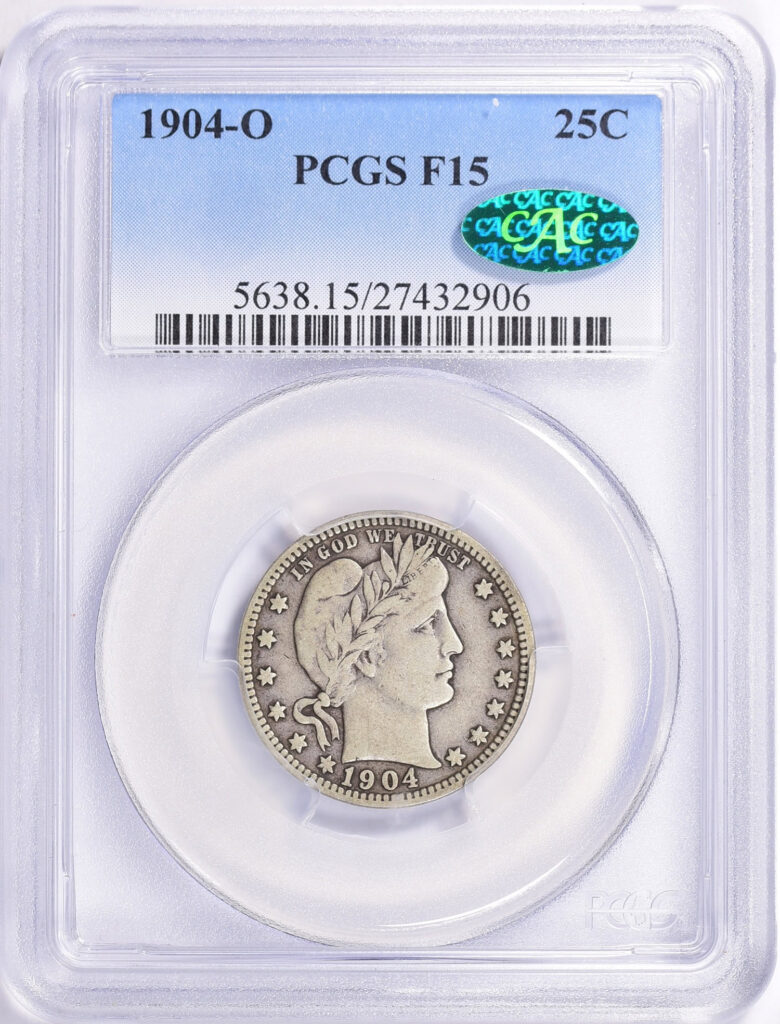
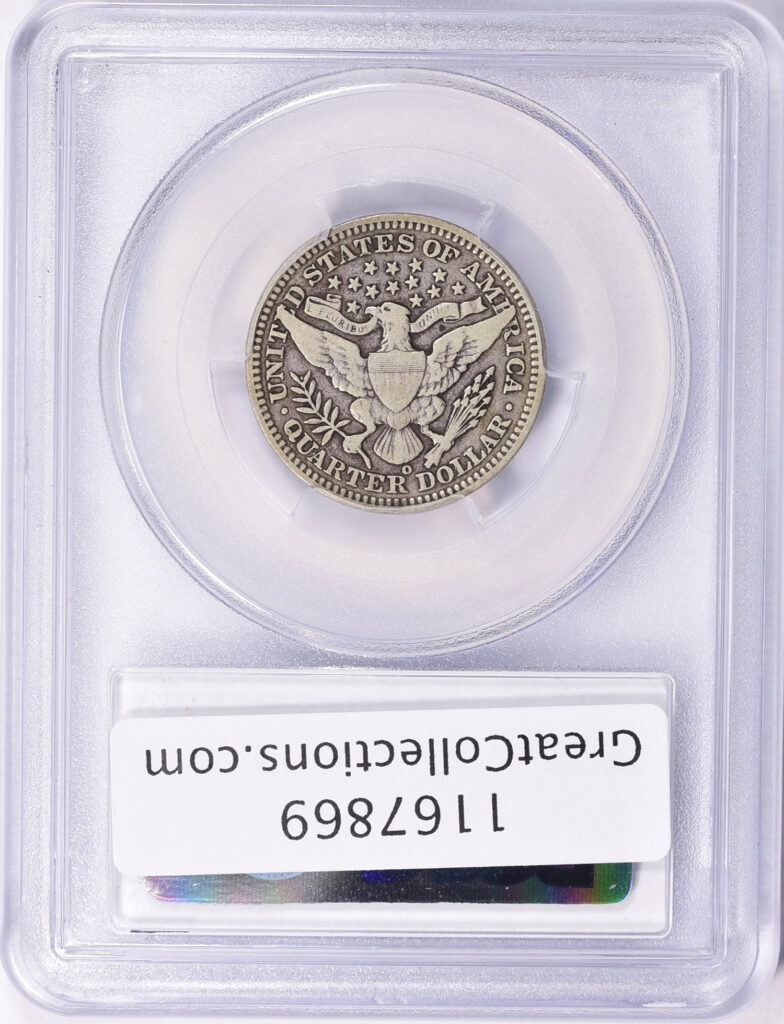

Tim Glaue’s View of the 1906-O
In an article in the Spring 2015 issue (Vol. 26; No. 1, pp. 10-16) of the journal of the Barber Coin Collectors Society (BarberCoins.org), an article by Tim Glaue challenges my view that the 1906-O is not particularly scarce in circulated grades. As Glaue notes, I mentioned this point in passing in an article in CoinWeek in 2012.
Then and now, I maintain that there are many 1906-O quarters in the Fine to XF grade range that have never been submitted to grading services. There are also more than a few PCGS or NGC graded 1906-O quarters that were not submitted to CAC in New Jersey because it is not cost-effective for pertinent dealers to submit them.
Price guides tend to place a retail value of a Fine-12 grade 1906-O in the $40 to $50 range and the value of a Fine-15 grade 1906-O at around $60. After figuring a grading fee, shipping costs, insurance and time, a typical dealer will probably not submit a Fine grade 1906-O for certification. Moreover, there is risk involved. Even sharp graders cannot perfectly predict CAC grades or which coins will merit numerical grades from CAC at any level. For Barber quarters in circulated grades, certified populations should be considered along with thoughts about those that are uncertified.
The CPG-CAC retail price estimate for a VF-35 grade 1906-O is $115. If a dealer pays $65 for a raw VF-35 grade 1906-O, he may not wish to pay a grading fee and incur expenses in the process of having it certified. Besides, some dealers are not able to sell classic U.S. coins for retail prices. If a dealer pays $60 for a raw 1906-O and later wholesales it for $80 there is no room in between for the payment of a grading fee, even though certification often adds to the value.
Returning to Tim Glaue’s article, I am glad that he explained that the ‘Great San Francisco Earthquake’ is the primary reason as to why there were no quarters minted in San Francisco in 1906. Nevertheless, Glaue’s report of a silver bullion shortage at the New Orleans Mint during the first half of 1906 is beside the point that more than two million 1906-O quarters were minted. If one percent (20,000+) survive, then 1906-O quarters would be fairly common in the present, and more than four thousand of those would grade in the Fine to XF range. If just one-quarter of one percent survive, there would be more than 5,000 1906-O quarters in existence.
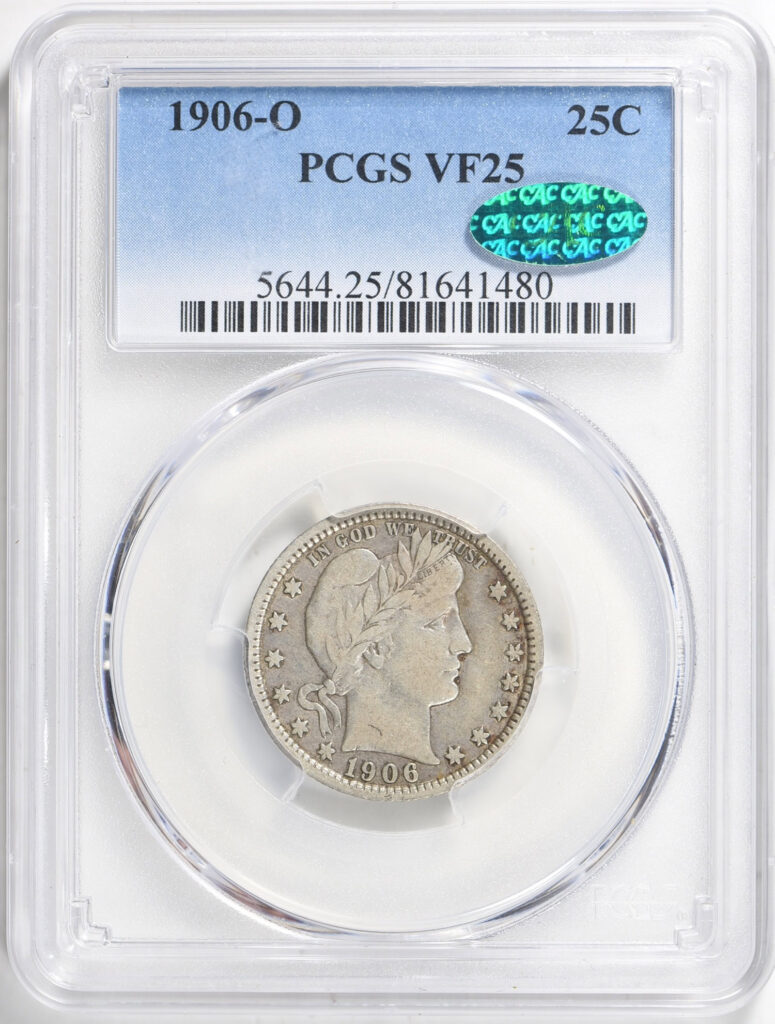
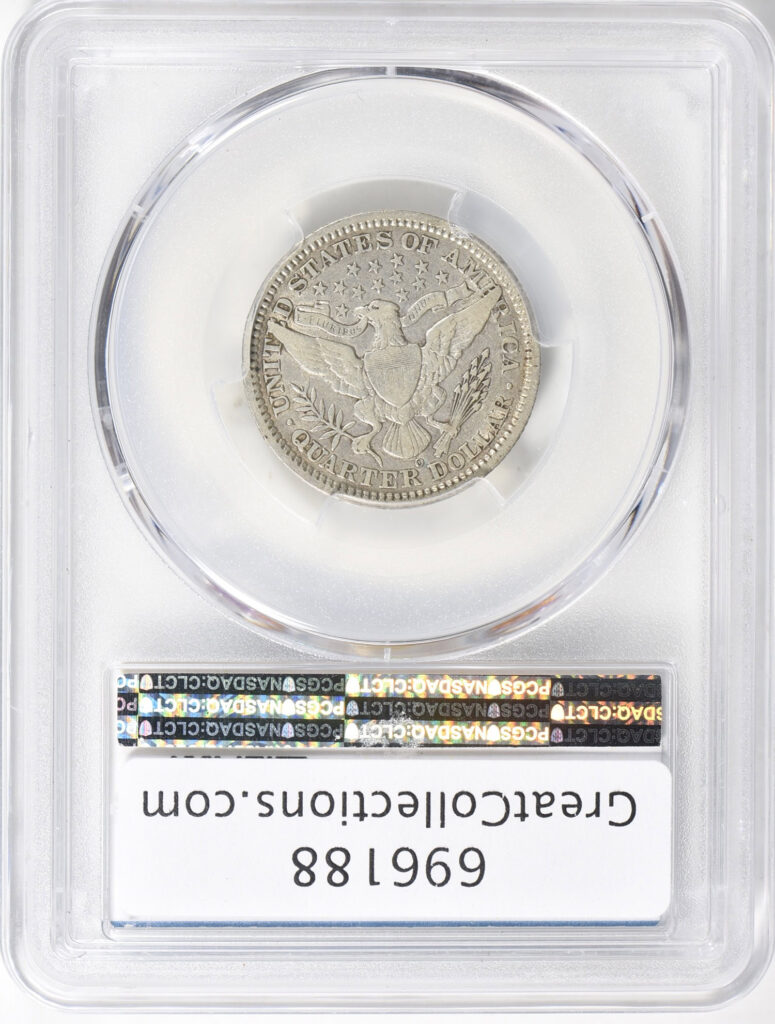
As for Glaue’s research regarding labor conditions, political issues and adverse weather in New Orleans during 1906, his remarks regarding the relationship of these factors to coin production are educational and I hope that Glaue was recognized for important research. These points, however, do not support his theory that Fine to XF grade 1906-O quarters are much scarcer than experts and price analysts have thought them to be. The mintage of 2,056,000, is almost as high as that for the 1904-O, 2,456,000, another year during which zero quarters were minted in San Francisco. Also, the total mintage of quarters at all U.S. Mints was significantly higher in 1906, 8,991,760, than it was in 1905, 8,081,523.
If a substantial portion of the mintage of 1906-O quarters occurred during the last quarter of the calendar year, a point which Glaue may be suggesting, the relatively high mintage of 1907-O quarters, 4,560,000, may be evidence that 1906-O quarters are not particularly scarce in the present. The mintage of quarters in New Orleans for the sixteen month period from September 1906 to December 1907 was relatively high. There were plenty of 1906-O and 1907-O quarters around to circulate for decades, and a significant number of both dates were gradually, over the years, pulled from change by collectors.
Barber Coin Collectors
An additional point is that most collectors of Barber quarters are not members of the Barber Coin Collectors Society (BCCS), though I certainly suggest that people join. Although surveys conducted by the BCCS are valuable for some purposes, it is extremely difficult to fairly estimate the population of raw Barber quarters overall.
For some reason, my grandmother had a large quantity of circulated 1914-D dimes, and multiple 1914-D quarters, too. She was never a member of the BCCS.
Besides, members of the BCCS are probably more concerned about the technical aspects of the coins in their collections than Barber coin collectors at large. As David Lawrence Feigenbaum emphasized, surviving 1906-O quarters often have mint-caused imperfections or were mishandled by collectors. Some of these imperfections, particularly a poor strike, would not upset most casual collectors, if they are even noticed at all. Members of the BCCS, however, would be far more likely to avoid buying 1906-O quarters with significant mint-caused imperfections and may not have many 1906-O quarters to report in member surveys. If a significant number of surviving 1906-O quarters were shunned by BCCS members, these same coins are likely to be owned by other collectors around the nation, and thus would not be included in surveys of BCCS members.
Most collectors assembling sets are comfortable with including some coins with noticeable imperfections in their sets, including 1906-O quarters that were not well struck at the New Orleans Mint. To build sets of classic U.S. coins, there is a need to be realistic about coins that can practically be obtained. Few classic U.S. coins are pristine, and many were not well struck.
Certainly, many collectors save money by acquiring key and semi-key dates that have noticeable flaws. In my articles on key and semi-key Barber quarters, here on the CAC site, the 1907-S, the 1908-S, the 1911-D and the 1914-S are covered. For decades, the 1909-O has been a famous semi-key.
The 1911-S and the 1912-S have not received as much attention as they deserve. The 1911-S has been overshadowed by the 1911-D. As a relatively scarce Philadelphia Mint issue, the 1913, captures some attention from the 1912-S. Someone focusing on the listings for the 1913 in a price guide might not pay much attention to the 1912-S.
CAC approved or CACG graded 1911-S and 1912-S quarters in the VF-20 to AU-53 grade range could cost anywhere from $100 to $325 each. A collector who can afford to spend a few dollars to contribute to ‘an education’ about Barber quarters may wish to buy some non-CAC 1911-S and 1912-S quarters and then submit them.
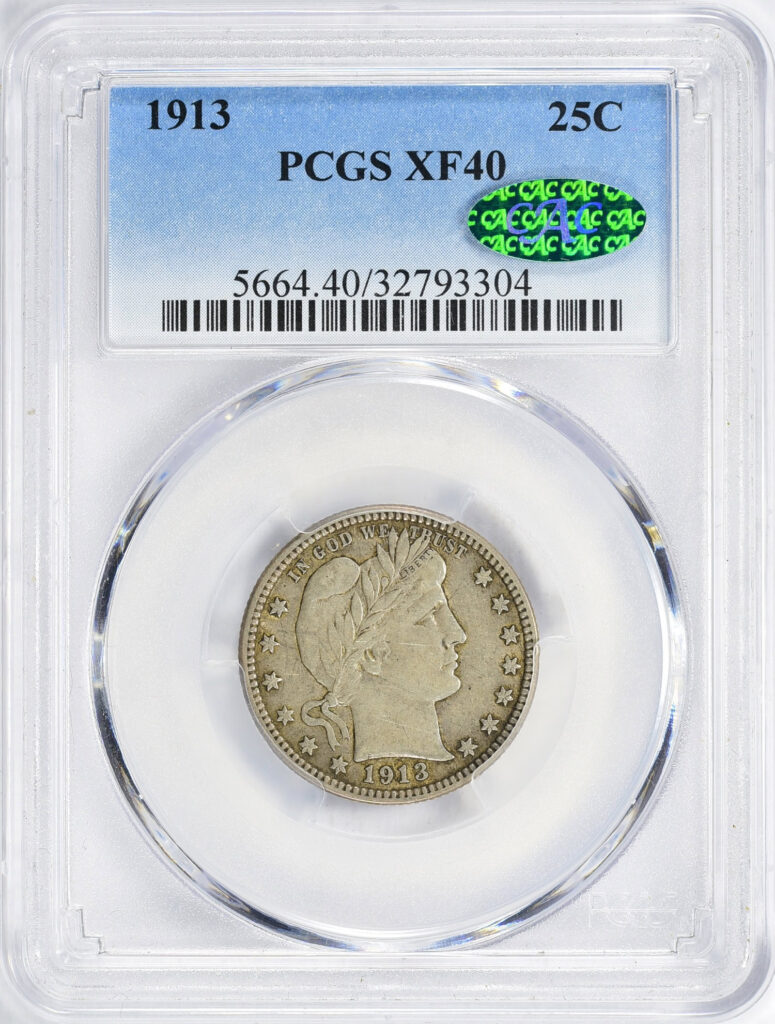
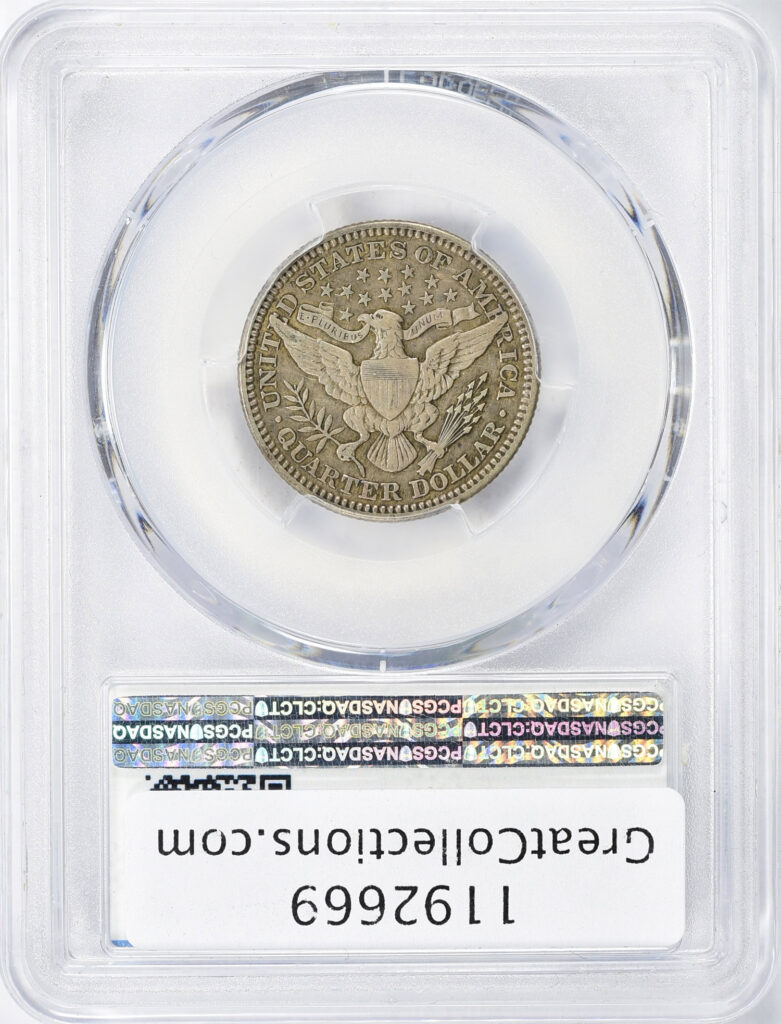
In the VF-20 to AU-53 grade range, the 1913 is extremely scarce, especially so for a Philadelphia Mint Barber quarter. On Oct. 16, 2022, GreatCollections sold a CAC approved VF-25 grade 1913 quarter for $495. On July 17, 2022, GreatCollections sold a CAC approved XF-40 grade 1913 quarter for $547.80.
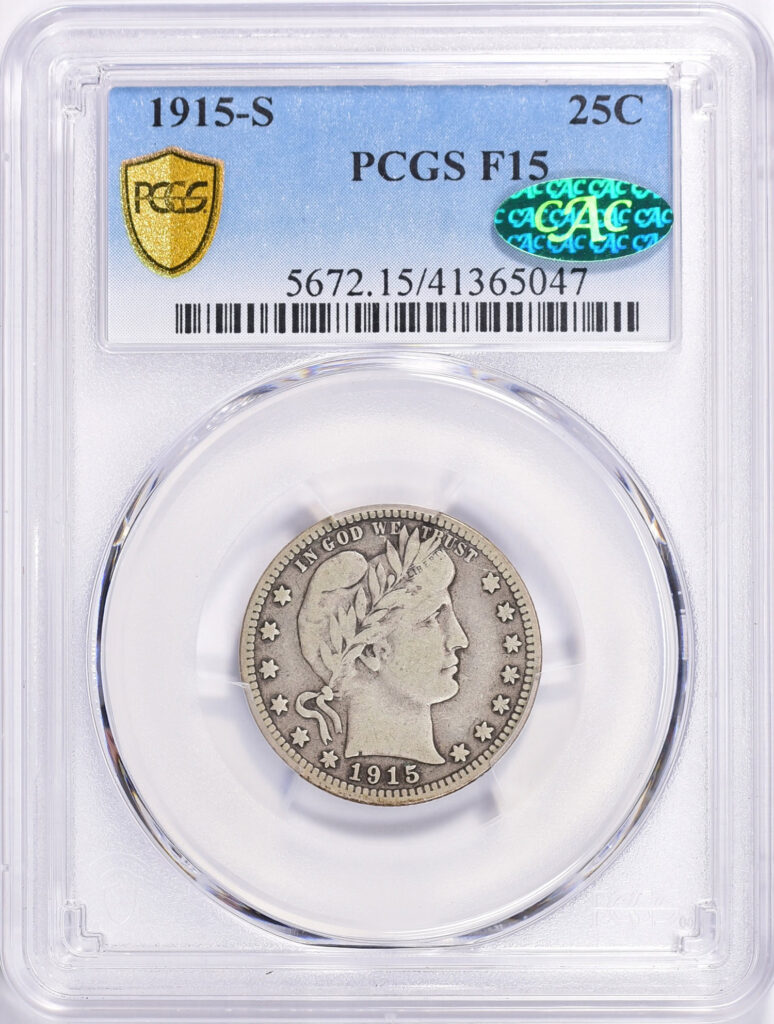
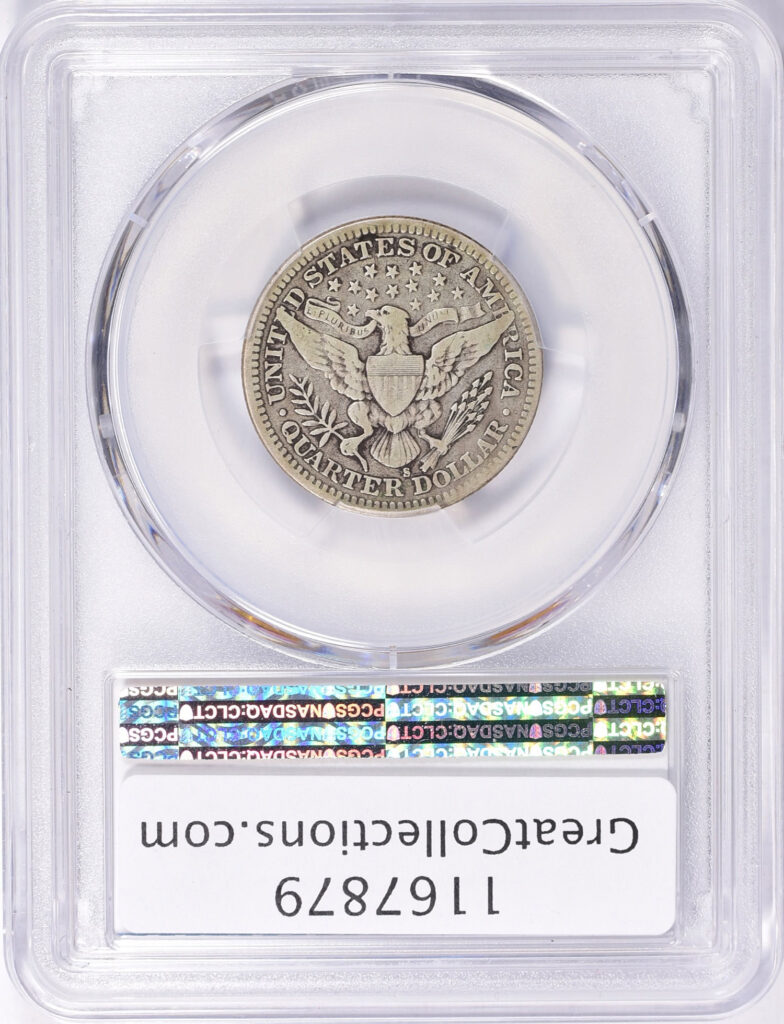
The 1914, 1914-D, 1915, 1915-D, 1916 and 1916-D are all among the least scarce dates. The 1915-S commands a premium. On June 12, 2022, GreatCollections sold a CAC approved Fine-15 grade 1915-S for $133.10. On Sept. 18, 2024, Heritage sold a CAC approved AU-55 grade 1915-S for $264.
A CAC-only set of circulated Barber quarters can be completed without spending a fortune and would be a very impressive accomplishment. Indeed, this would be a challenging quest that is logical, consistent with coin collecting traditions, and not very costly.
Images are shown courtesy of GreatCollections in Irvine, California.
Copyright © 2025 Greg Reynolds
About the Author
Greg is a professional numismatist and researcher, having written more than 775 articles published in ten different publications relating to coins, patterns, and medals. He has won awards for analyses, interpretation of rarity, historical research, and critiques. In 2002 and again in 2023, Reynolds was the sole winner of the Numismatic Literary Guild (NLG) award for “Best All-Around Portfolio”.
Greg has carefully examined thousands of truly rare and conditionally rare classic U.S. coins, including a majority of the most famous rarities. He is also an expert in British coins. He is available for private consultations.
Email: Insightful10@gmail.com
